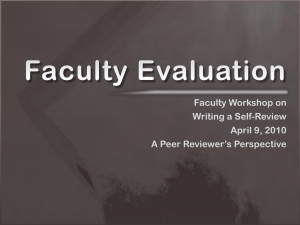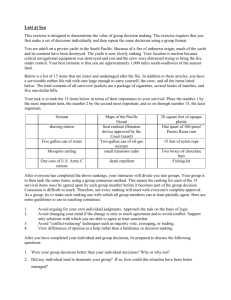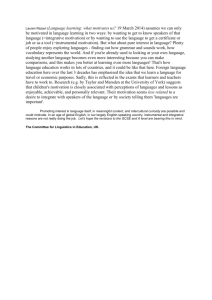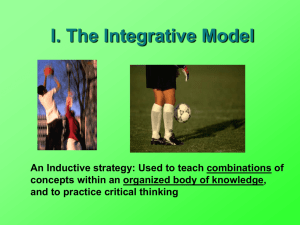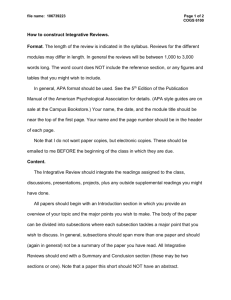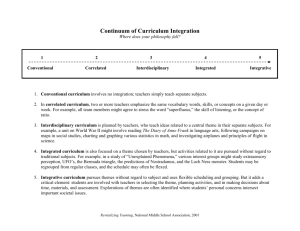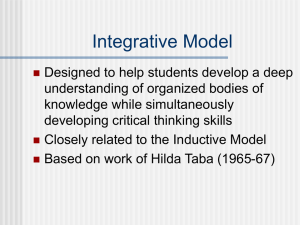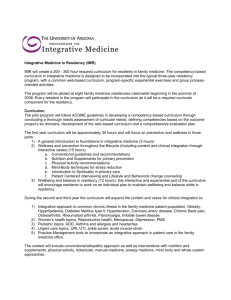cae_conf09_inte_learn
advertisement
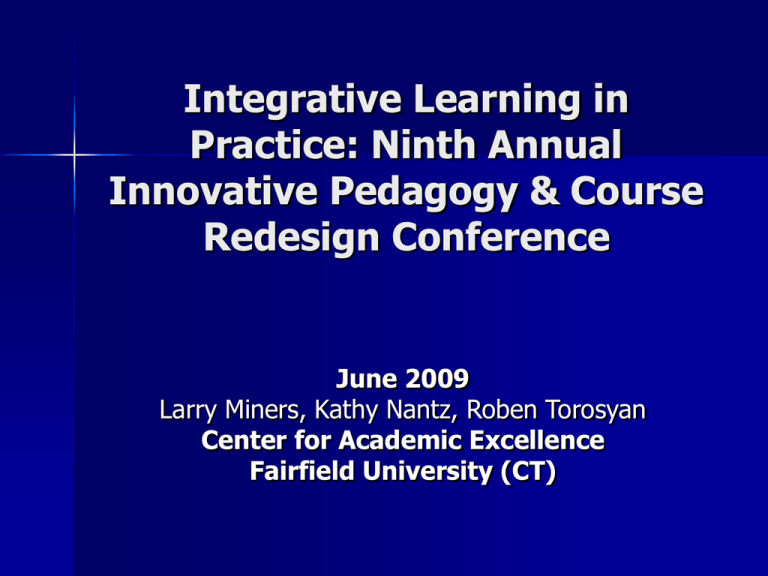
Integrative Learning in Practice: Ninth Annual Innovative Pedagogy & Course Redesign Conference June 2009 Larry Miners, Kathy Nantz, Roben Torosyan Center for Academic Excellence Fairfield University (CT) Goals tonight: Meet new colleagues Think outside the box about integrative learning (not economics needs accounting, but learn economics by sailing, for example) Start brainstorming ways to design an entire integrative course, or to make a course or project of your own more integrative 6/17 Names On your name-tent, write: – Name – One thing unique to them Integrative Learning in Practice: Let’s Connect Lost at Sea 1,000 miles south-southwest of nearest land Contents of everyone’s pockets: 15 items Which items do you rank most important to your survival? Rank them 1 being most important, 15 being least 6/17 Lost at Sea ____ ____ ____ ____ ____ ____ ____ ____ ____ ____ ____ ____ ____ ____ ____ Sextant Shaving mirror 5 gallon can of water Mosquito netting 1 case of U.S. Army C rations Maps of the Pacific Ocean Seat cushion (Coast Guard approved flotation device) 2 gallon can of oil-gas mixture Small transistor radio Shark repellent 20 square feet of opaque plastic 1 quart of 100-proof Puerto Rican rum 15 feet of nylon rope 2 boxes of chocolate bars Fishing kit 6/17 Lost at Sea: Your priorities ____ ____ ____ ____ ____ ____ ____ ____ ____ ____ ____ ____ ____ ____ ____ Sextant Shaving mirror 5 gallon can of water Mosquito netting 1 case of U.S. Army C rations Maps of the Pacific Ocean Seat cushion (Coast Guard approved flotation device) 2 gallon can of oil-gas mixture Small transistor radio Shark repellent 20 square feet of opaque plastic 1 quart of 100-proof Puerto Rican rum 15 feet of nylon rope 2 boxes of chocolate bars Fishing kit 6/17 Lost at Sea: Your priorities *****____ 5 gallon can of water ****____ 1 case of U.S. Army C rations ****____ 20 square feet of opaque plastic ***____ Shaving mirror **____ 15 feet of nylon rope *____ Mosquito netting *____ Seat cushion (Coast Guard approved flotation device) *____ 2 gallon can of oil-gas mixture *____ Small transistor radio *____ 1 quart of 100-proof Puerto Rican rum *____ 2 boxes of chocolate bars *____ Fishing kit ____ Maps of the Pacific Ocean ____ Shark repellent ____ Sextant 6/17 Lost at Sea: US Coast Guard’s priorities Type here 6/17 Integrative Learning: Meanings connecting skills and knowledge from multiple sources and experiences applying theory to practice in various settings utilizing diverse and even contradictory points of view understanding issues and positions contextually (Huber & Hutchings, Integrative Learning, 2004) 6/17 One kind of integration: Interdisciplinary Understanding A definition: “the capacity to integrate knowledge and modes of thinking in two or more disciplines or established areas of expertise to produce a cognitive advancement—such as explaining a phenomenon, solving a problem, or creating a product—in ways that would have been impossible or unlikely through single disciplinary means” (Boix Mansilla & Dawes Duraising, Journal of Higher Education, 2007, p. 219) 6/17 Integrative Learning Outcomes Begin approaching a new topic or problem by drawing on prior learning Take different perspectives on an issue Combine academic and community-based work Take advantage of new opportunities Practice critical reflection and document it Cf. Huber & Hutchings, Integrative Learning: Mapping the Terrain, 2004 Teaming up 1-2-3, 4-5-6, 7-8-9, 10-11-12, 13-14-15, 16-17-18, 19-20-21, 22-23-24, 25-26-27, 28-29-30, 31-32-33, 34-35-36, 37-38-39, 40-41-42, 43-44-45, 46-47-48, 49-50-51, 52-53-54, 55-56-57, 58-59-60, 61-62-63, 64-65-66, 67-68-69 While adrift: Course design Each one of you MUST be involved in the development of the syllabus and have something to contribute to the teaching of the course. 1. Name of course you will teach? 2. Three goals: What do you want your students to know, to do, and/or to care about? 3. Three activities, exercises, in or out of class experiences, etc. to help students achieve these goals. Integrative Courses Survival (No Pre-wrecks!) Marketing, Sustainability & A Green Economy: meaning, audits, living Lost: Analyzing behaviors of disorientation: an ethno-discursive- mathematical-anthropological analysis; relationships under stress; interdependence with others Integrative Courses Sustaining your not-for-profit organization: manage finances, comply w/ regs., become sustainable without grants. Academic lego. How would you Use objects to solve problems in real world. Integrative Courses Type here Connecting: Take-aways What skills did you use? What unexpected connections did you make? What will you use when you go home, to inform your teaching or other professional practice? Connecting: Take-aways Start by agreeing on goals rather than readings, focuses on learning Meld. Teamwork is fun. Icebreakers as teaching tools. Connecting: Take-aways Type here Connecting: Take-aways Type here Lost at Sea: priorities according to the U.S. Coast Guard 1. 2. 3. 4. 5. 6. 7. 8. 9. 10. 11. 12. 13. 14. 15. Shaving mirror: to signal (#1 priority for rescue) 2 gallon can of oil-gas mixture: signal by burning 5 gallon can of water: replenish fluids 1 case of U.S. Army C rations: food 20 square feet of opaque plastic: collect rain water & as shelter 2 boxes of chocolate bars: reserve food supply Fishing kit: to get food, although ready food is more important 15 feet of nylon rope: lash people or equipment together Seat cushion (Coast Guard approved flotation device): life preserver Shark repellent: enough said 1 quart of 100-proof Puerto Rican rum: 80% alc. = antiseptic Small transistor radio: out of range of radio station Maps of the Pacific Ocean: worthless without navigation equipment Mosquito netting: no mosquitos in mid-Pacific; to fish, use the kit Sextant: useless without relevant tables and a chronometer 6/17 Dream Learning Goals Imagine you could design your dream course or learning experience for students. If a student reached your dream learning goals, what would change? Write: Five years later, they would: – Know… – Do… – Value… A common visual “text” View clip: http://www.pbs.org/wgbh/pages/frontline/meltdo wn/view/ Imagine using this clip to reach one or more of your dream goals. (Factors include the psychology, power politics, media influence on behavior, imagery, history, communication patterns, you name it) Circle share: one goal and the clip’s relevance A common visual “text” Brainstorm individually: How could other disciplinary theories, findings, examples, methods, validation criteria, genres, or forms of communication help ground student understanding? How could other disciplinary insights be integrated to advance understanding—that is, using integrative devices such as conceptual frameworks, graphic representations, models, metaphors, complex explanations, or solutions that results in more complex, effective, empirically grounded, or comprehensive accounts or products? (Boix Mansilla & Dawes Duraising, Journal of Higher Education, 2007, p. 222) Connecting Across Disciplines Connect with one concept mentioned during circle share: – I think ---- concept in my discipline may relate to ---- concept in ---- discipline, maybe in ------ way – Here’s a real world problem, and it requires understanding ---- concepts from ---- disciplines Examples Across Disciplines Self-awareness: Come up w/ probing questions (we and students do!) to push students to the next level of understanding themselves. Lifelong learning: Ability to generalize, see concept in their own lives, and apply them. Social justice / service: See consequences of their actions. Not just aware, but get practice taking that to make a difference in community. Quantitative literacy, how to interpret statistics, is essential to so many problems. Not just skills but what the purpose of the skills is. Recognize what you don’t know as much as what you do know. Integrative Cartoons: Capturing Visual Analogs Take 60 seconds to doodle, creating an image—use icons, lines, shapres, drawings, cartoons, symbols, stick figures or logos—to represent one concept that required more than one discipline Label the cartoon or doodle Connecting Across Disciplines What’s shared? (concepts, ideas, concerns, pedagogies/teaching methods) What’s different? Given your conversations, might you teach any differently in the future? If so, how?
